
In response to Rob’s request last week for input about Osage orange, several of you have thoughts and project photos to share. – Editor
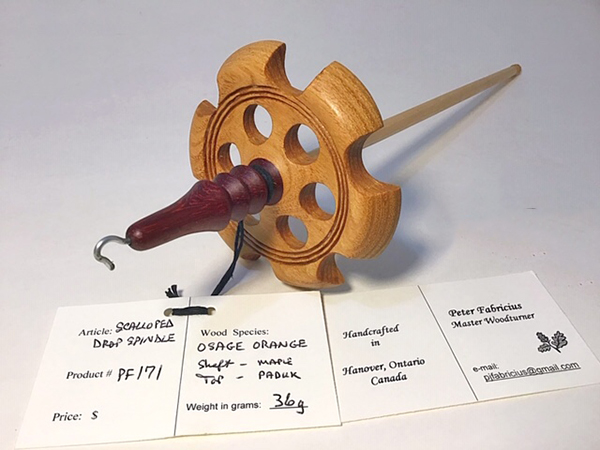
“Here is a project I completed in 2021. It is a drop spindle that is used to spin wool into yarn so you can knit a sweater, socks or a warm winter hat. I must admit that I cannot use this tool, but I sure can make a variety of models for the spinners and weavers that buy them. My latest spindle is #PF247, so I guess I have made a few! I have used many different woods and drop spindle models. Good luck with your project! I have no issues with Osage orange; it handles very nice, like maple.” – Peter Fabricius

“I got a free log of Osage orange from the Ohio Valley Woodturners Guild. This is a bowl I turned from it. Kind of heavy wood but easy to turn. Beautiful grain and color.” – Paul Trenn
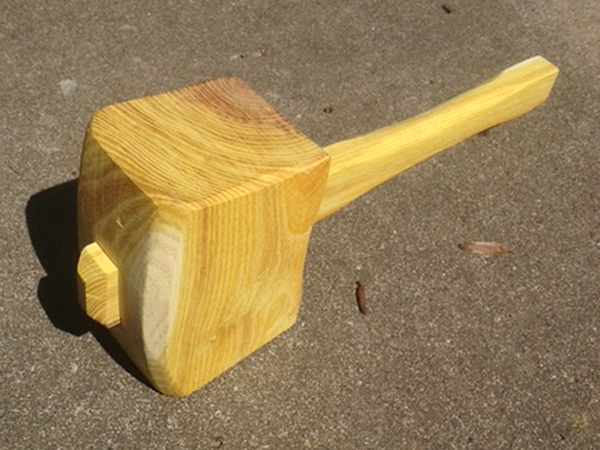
“The Osage orange for this mallet was cut on my WoodMizer mill. (Osage orange) cuts easily when green but hard as a rock when dry. The mallet is a Paul Sellers design.” – Stan Stevens
“I have turned many bowels from Osage orange. I get it from my wife’s family farm in Kansas. We cut some branches and bring it home to California. When fresh it is very dense and works like butter. It is my favorite wood to turn.” – edr1201
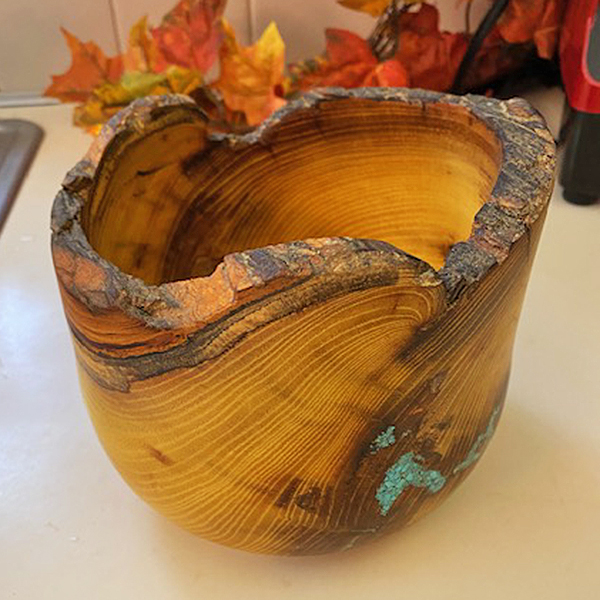
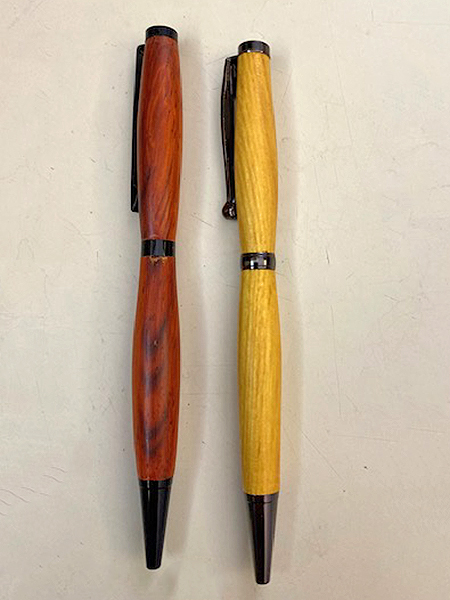
“I recently moved to Kansas City. My real estate agent showed me her wood pile for her fireplace and there were some Osage orange (also called hedge apple) logs in it. She let me have a couple! So far, I have one bowl (turquoise/CA glue inlay in the bug holes), several pens (it’s the right one in the photo of two pens), two more bowl blanks that are waiting for the right time to meet my lathe and a whole bunch of pen blanks that are ready to be turned. Osage is hard, and it is tough on my turning tools. I hit the CBN wheel often. But when it is finished, the surface can be glass smooth. If you want to retain the yellow color, keep it out of sunlight. UV light will turn it more orange/brown.” – Dennis Sosnovske
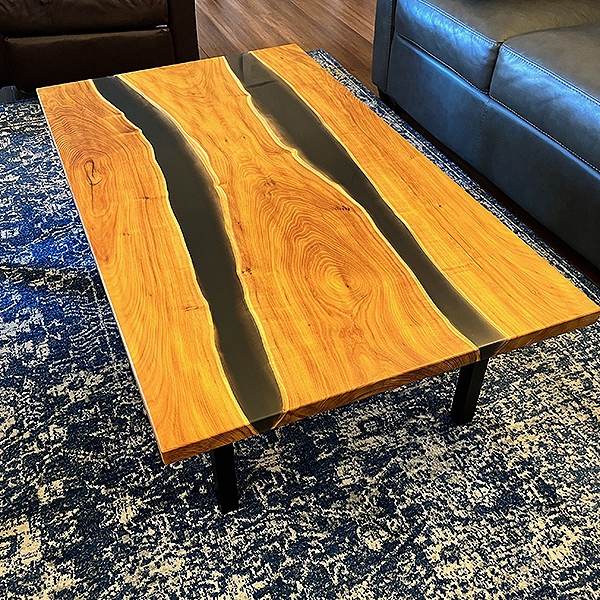
“Here is a picture of a coffee table I built out of two live-edge slabs of Osage orange. I finished the table with Rubio Monocoat.” – Bill Swenson
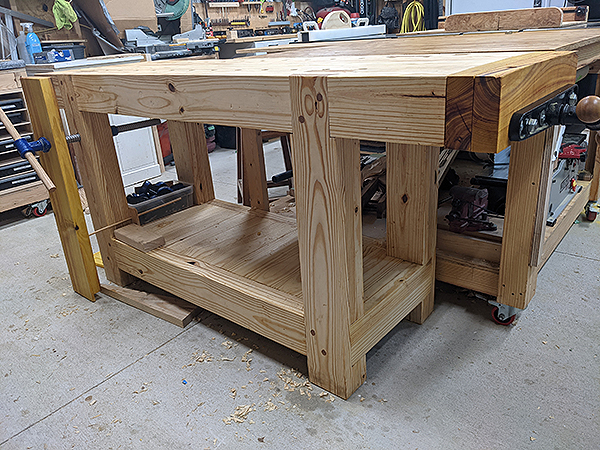
“Here is my use of a slab of Osage orange I got from a street market dealer in raw wood. It was very, very hard, brittle to the planer and therefore tough to mill smooth, but it sure made two great vise faces for my home-built workbench. The bench in the back is the old bench, now converted to counters and stands for other tools.” – Rolf Peterson
“Osage orange makes great knife scales. It’s an attractive vanilla color and ages to a deep yellow patina. It is very strong and wears well while resisting unwanted stains. I used a boiled linseed oil finish.” – Merril Littlewood
“I just have bought my first amount of Osage lumber at the local Rockler store in South Portland Maine. I have been in woodworking most of my life but as the financial VP of a large shop in the beginning. I had a mid-life crisis and started my own company in my late 40s. Loved it. Now, in my late 70s, I’m finding that lifting sheets of plywood and 8/4 oak and mahogany lumber is beyond my abilities. I am attempting to learn woodcarving, which is difficult for a numbers guy. Anyway, living in Maine led me to think about the thing that Maine is known for: lobsters. Not being much of an artist and looking at my latest meal of boiled lobster, I saw an opportunity to enjoy a great meal and my next attempt at carving. Which brings me to the purchase of Osage lumber. As you know when boiled, lobsters turn a bright orange. The next visit to the Rockler store, I went straight to the cutoff lumber bin. There happened to be a good supply of Osage lumber. Will try to send a picture of the creation when it’s completed. Please don’t hold your breath, as things at my age don’t happen fast. Keep up the good work.” – Brad Hamel
“Welcome to the South and one of one of the most prolific trees. It grows like bamboo. It is tough as steel. You need to be careful, however, around the trees. They have 2” thorns and grapefruit-sized fruit that are hard as golf balls. Cutting one down usually wears out three chainsaw chains. But it is beautiful wood that needs to be sealed as soon as you work with it. It turns black with oxidation.” – Ed Frankenfeld

“I made this storage box for my dulcimer, probably 25 years ago. Our instructor had picked up the wood from a local sawmill and allowed me to use it for the project. There was a lot of grain direction change, and it was impossible for a novice to keep from chipping out the wood on the jointer and planer. It is still one of my favorite builds due to the funky look of the boards. I suspect that your project will be much nicer. Have fun with it!” – Randy Martin





